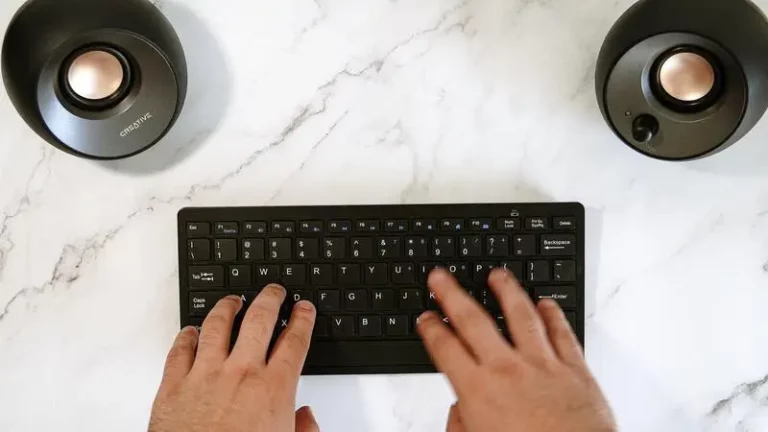The Pros and Cons of Buying a Wireless Keyboard (Explained)
This site contains affiliate links to products, and we may receive a commission for purchases made through these links.
Whether you are a gamer, writer, or television enthusiast, getting a wireless keyboard is one of the best things you can do for yourself.
Due to technology, you can enjoy gaming and typing without worrying about endless wires.
You may be wondering how a wireless keyboard work and feel different from a wired keyboard?
The answer is that a wireless keyboard gives you less strain and greater comfort.
Now that you know the basic differences, you might be wondering if there’s more?
Luckily I have you covered as I’ve explained all you need to know to make a qualified decision:

How does a Wireless Keyboard Work?
A wireless keyboard works without using any wires connecting to your laptop, tablet, or computer. Instead, it uses a radio frequency, Bluetooth, or infrared technology to connect to your other devices.
Radio Frequency Enabled Wireless Keyboard
A wireless keyboard that works with radio technology will generally cover a range from 27 MHz to 2.4 GHz. Most new wireless keyboards function with a 2.4 GHz RF or radiofrequency.
The radiofrequency on your wireless keyboard will have two parts: a receiver and a transmitter.
The transmitter is located inside the keyboard. And the receiver plugs into the keyboard port or USB port to enable the wireless keyboard.
Bluetooth Technology
Bluetooth technology is relatively new and has been popular since 2011. While using Bluetooth technology, your wireless keyboard will connect through the Bluetooth protocol.
Most people think of Bluetooth wireless keyboards as more portable. This is because the technology is fundamentally used for devices that are portable, including tablets and smartphones.
One disadvantage of using Bluetooth keyboards is that they are often not compatible with various operating systems.
Radio Frequency Vs. Bluetooth Keyboards
A wireless technology, Bluetooth was quite popular at the beginning of the new millennium. However, it did not work well with personal computer peripherals except for headphones and other smaller input devices.
RF technology used in most peripherals is referred to as wireless. These devices use radio waves for communicating through radio frequency or RF. In others, a USB receiver is plugged into the laptop or personal computer.
While many people mix up the two and think that wireless radio frequency and Bluetooth are the same, they are not.
Contemporary wireless keyboards generally communicate through the 2,4 GHz frequency. This enables them to communicate with devices that are as far as 30 feet.
Bluetooth devices use a dongle too, yet their range is often within 10 feet.
The conclusion is that most wireless keyboards use radiofrequency.
The Pros of Buying a Wireless Keyboard
There is a difference of opinion between users about which keyboard is better, a wireless keyboard or a wired one.
Office and home users prefer wireless keyboards as they are less expensive.
However, there is a lot more to this discussion, and here are some advantages of using a wireless keyboard.
Reduced Clutter
One of the biggest selling points for wireless keyboards is the reduced desk mess. You do not have to stress over the cables all over your desk or behind the screen.
This means that you can have some additional desk space if you use a wireless keyboard. You can surely see that this is a big advantage of using wireless keyboards.
If you are a neatness freak or a minimalist, you will love the modern, clean look of your workspace. And you should surely opt for the wireless keyboard.
You need to choose the keyboard that suits you and your requirements.
Freedom to Move Around
Most often, a Bluetooth device has a 33-feet range. A radio frequency wireless keyboard generally has a 6-feet to 30-feet range depending on the kind of technology it uses.
If you are far away from your computer, you may be at risk of disturbance from obstacles or lag.
However, the freedom to move around or sit far away with a wireless keyboard can be especially useful. This includes situations such as on-screen collaborations with colleagues or navigating through presentations.
If you are working from home, you can sit on your bed or couch and control your devices from any part of the room.
Before you decide which is the right keyboard for you, think about how far you usually sit from your screen.
Ease for Frequent Travellers
When you are using a wireless keyboard, traveling is more convenient. You do not have to worry about wrapping up your wires or dealing with tangled wires while on the go.
The USB receiver can remain plugged into your laptop, so you resume work instantly in a cafe or train. You do not have to fumble around looking for the right port each time you want to use your device.
If you use a Bluetooth keyboard, it will be easy to carry as it does not need any wires either.
Some Bluetooth keyboards also come with unique split designs, which can help you fit them in smaller spaces.
Good Workstation Ergonomics
A cleaner desk will make it easier for you to position your wireless keyboard for a comfortable posture and alignment.
It is important that your keyboard is centered according to your body. This way, you can work more comfortably and focus on the task at hand.
The good part is that you do not have to lean or twist to reach for your keyboard. This can save you from aches and pains, or even injuries in the long run.
Connect Multiple Devices
If you are looking for a keyboard to use with one device, such as your laptop or desktop, a radiofrequency wireless keyboard will work.
However, if you have several devices to connect, a Bluetooth keyboard will be very useful.
The Bluetooth keyboard enables you to connect one keyboard with every device, and you do not have to plug it.
Cons of Buying a Wireless Keyboard
Despite the numerous pros I have put forth, you may have observed that many people continue to work with wired keyboards.
The reason is that there are some disadvantages to buying and using wireless keyboards.
Here is a detailed review of the cons of using a wireless keyboard.
Slower Performance due to Possible Interference
Although this does not happen often, wireless keyboards can struggle with interference or work somewhat slower than wired keyboards.
Most users may not even notice these lapses in performance.
However, this is a big issue for gamers or high-performance IT professionals.
This is why professionals often prefer wired keyboards because they need fast and consistent response times and cannot tolerate input lag.
Charging Problems
A wireless keyboard is not plugged into an electrical socket and needs the power to function. This power comes from high-performance batteries that generally have a long life.
However, anyone who uses a wireless keyboard may be familiar with the situation when they were stuck with it being dead. The solution is to always keep a backup supply of batteries so that your work is not disrupted.
All Bluetooth devices need to be charged to power them, and so does the Bluetooth keyboard.
Additionally, the power gets used very quickly because the keyboard needs more power than other Bluetooth devices. So be prepared to charge it often.
Replacement Batteries
A wireless keyboard needs batteries to function. While it may seem much like a one-time expense, it is actually not.
Based on the frequency of usage, you will continue to need replacement batteries, which carries an ongoing expense.
Higher Cost
Wireless keyboards generally cost more than wired ones. This is especially true for Bluetooth-enabled wireless keyboards.
Bluetooth keyboards cost nearly double in comparison to usual keyboards, which is why they are less popular.
If you want to keep your expenses in control, a wireless keyboard may not be the right choice.
People do not like to spend on products that are more expensive and less durable in comparison to alternate products.
Security
There are some concerns that wireless keyboards may not be very secure.
Due to security concerns, some employers eliminate this risk completely. This is why some companies only allow the use of wired devices for their employees.
Less Reliable
The durability of wireless keyboards does not match that of wired ones.
They have shorter lives in comparison to wired keyboards. You also have to handle them with greater care because they are more fragile.
Why do Wireless Keyboards have Interference Problems?
Any kind of wireless technology may have signal interference. The reason is that wireless devices use radio waves for communication, and they can become scrambled.
This applies to wireless keyboards you may use at your home or office. But why does this happen?
This problem usually occurs because of other devices that use radiofrequency, such as printers or headphones using the same frequency.
It could even be something as random as your microwave. The electromagnetic fields or EMFs they emit can disrupt the operation of your wireless keyboard.
However, you can manage this with a little planning. Make sure that your workstation at work or at home is not near any such devices.
Once you find the right spot, your wireless keyboard will work completely smoothly.
How to Find the Right Wireless Keyboard?
Finding the right wireless keyboard is very important.
This is a subjective decision because you may have your own particular preferences and requirements. Think about your options carefully before you decide.
The first thing to consider is what you mostly use your keyboard for, such as programming, typing, or gaming.
Spaced and sculpted keys are very comfortable for typing, whereas gamers have a preference for mechanical keyboards.
On the other hand, programmable keys and windows hotkeys are more important for programmers.
Another factor is your work style. Do you work in one place, or do you have to carry your keyboard around? This is an important element because the keyboard size influences how portable it is.
A wireless keyboard with more portability has fewer features to make it smaller and easier to carry around.
Furthermore, the price of a wireless keyboard must fit within your budget.
Generally, a Bluetooth keyboard is slightly more expensive than a radio frequency keyboard that functions with a USB drive.
What are the Key Features of a Wireless Keyboard?
The key features you can use to assess a USB receiver wireless keyboard or a Bluetooth keyboard include specific elements.
These include ergonomics, battery life, number pads, extra functional keys, inactivity detection, backlit, mechanical keys or membrane keys, and compatibility.
Measure and assess these elements irrespective of which wireless keyboard you choose.
A keyboard that is well-designed will feel right on your fingertips, which means either hard or smooth to press. It will also have the right keyboard layout, which means that the keys will be well-spaced or closer together.
You may also choose a keyboard that is backlit or not so that you can adjust the settings and work comfortably in poor lighting.
The last key quality is the battery life so that you can be prepared for when the battery must be replaced.
Wireless Vs. Wired Keyboard
Now that you have gone through a detailed analysis of the pros and cons of buying a wireless keyboard, you are ready to make an informed decision.
Once you understand how does a wireless keyboard work, you can make a better decision. If you are a programmer or a gamer, you are likely to use a wired keyboard.
For the average office or home user, the wireless keyboard is likely to be more convenient and practical for you.
The bottom line is that wireless keyboards are here to stay because, for the common user, the benefits outweigh the disadvantages.
The basic deciding factor is what you plan to use your keyboard for.

Espen
Espen is the Director of ProPairing and has written extensively about Bluetooth devices for years. He is a consumer product expert and has personally tested Bluetooth devices for the last decade.






